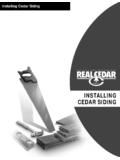Transcription of F-053 Elevation Certificate - Premier Flood
1 Building DiagramsThe following diagrams illustrate various types of buildings. Compare the features of the building being certified with the features shown in the diagrams and select the diagram most applicable. Enter the diagram number in Item A7, the square footage of crawlspace or enclosure(s) and the area of Flood openings in square inches in Items c, the square footage of attached garage and the area of Flood openings in square inches in Items c, and the elevations in Items h. In A zones, the floor Elevation is taken at the top finished surface of the floor indicated; in V zones, the floor Elevation is taken at the bottom of the lowest horizontal structural member (see drawing in instructions for Section C).DIAGRAM 1A All slab-on-grade single- and multiple-floor buildings (other than split-level) and high-rise buildings, either detached or row type ( , townhouses); with or without attached garage.
2 Distinguishing Feature The bottom floor is at or above ground level (grade) on at least 1 side.* DIAGRAM 2A All single- and multiple-floor buildings with basement (other than split-level) and high-rise buildings with basement, either detached or row type ( , townhouses); with or without attached garage. Distinguishing Feature The bottom floor (basement or underground garage) is below ground level (grade) on all sides.* * A floor that is below ground level (grade) on all sides is considered a basement even if the floor is used for living purposes, or as an office, garage, workshop, 2B All single- and multiple-floor buildings with basement (other than split-level) and high-rise buildings with basement, either detached or row type ( , townhouses); with or without attached garage. Distinguishing Feature The bottom floor (basement or underground garage) is below ground level (grade) on all sides; most of the height of the walls is below ground level on all sides; and the door and area of egress are also below ground level on all sides.
3 *DIAGRAM 1B All raised-slab-on-grade or slab-on-stem-wall-with-fill single- and multiple-floor buildings (other than split- level), either detached or row type ( , townhouses); with or without attached garage. Distinguishing Feature The bottom floor is at or above ground level (grade) on at least 1 side.* NFIP Elevation Certificate Instructions Page 7 of 9 Building DiagramsDIAGRAM 3 All split-level buildings that are slab-on-grade, either detached or row type ( , townhouses); with or without attached garage. Distinguishing Feature The bottom floor (excluding garage) is at or above ground level (grade) on at least 1 side.*DIAGRAM 4 All split-level buildings (other than slab-on-grade), either detached or row type ( , townhouses); with or without attached garage. Distinguishing Feature The bottom floor (basement or underground garage) is below ground level (grade) on all sides.*DIAGRAM 5 All buildings elevated on piers, posts, piles, columns, or parallel shear walls.
4 No obstructions below the elevated floor. Distinguishing Feature For all zones, the area below the elevated floor is open, with no obstruction to flow of floodwaters (open lattice work and/or insect screening is permissible). DIAGRAM 6 All buildings elevated on piers, posts, piles, columns, or parallel shear walls with full or partial enclosure below the elevated floor. Distinguishing Feature For all zones, the area below the elevated floor is enclosed, either partially or fully. In A Zones, the partially or fully enclosed area below the elevated floor is with or without openings** present in the walls of the enclosure. Indicate information about enclosure size and openings in Section A Property Information. * A floor that is below ground level (grade) on all sides is considered a basement even if the floor is used for living purposes, or as an office, garage, workshop, etc. ** An "opening" is a permanent opening that allows for the free passage of water automatically in both directions without human intervention.
5 Under the NFIP, a minimum of 2 openings is required for enclosures or crawlspaces. The openings shall provide a total net area of not less than 1 square inch for every square foot of area enclosed, excluding any bars, louvers, or other covers of the opening. Alternatively, an Individual Engineered Flood Openings Certification or an Evaluation Report issued by the International Code Council Evaluation Service (ICC ES) must be submitted to document that the design of the openings will allow for the automatic equalization of hydrostatic Flood forces on exterior walls. A window, a door, or a garage door is not considered an opening; openings may be installed in doors. Openings shall be on at least 2 sides of the enclosed area. If a building has more than 1 enclosed area, each area must have openings to allow floodwater to directly enter. The bottom of the openings must be no higher than foot above the higher of the exterior or interior grade or floor immediately below the opening.
6 For more guidance on openings, see NFIP Technical Bulletin Elevation Certificate Instructions Page 8 of 9 Building DiagramsDIAGRAM 8 All buildings elevated on a crawlspace with the floor of the crawlspace at or above grade on at least 1 side, with or without an attached garage. Distinguishing Feature For all zones, the area below the first floor is enclosed by solid or partial perimeter walls. In all A zones, the crawlspace is with or without openings** present in the walls of the crawlspace. Indicate information about crawlspace size and openings in Section A Property 9 All buildings (other than split-level) elevated on a sub-grade crawlspace, with or without attached garage. Distinguishing Feature The bottom (crawlspace) floor is below ground level (grade) on all sides.* (If the distance from the crawlspace floor to the top of the next higher floor is more than 5 feet, or the crawlspace floor is more than 2 feet below the grade [LAG] on all sides, use Diagram 2A or 2B.)
7 DIAGRAM 7 All buildings elevated on full-story foundation walls with a partially or fully enclosed area below the elevated floor. This includes walkout levels, where at least 1 side is at or above grade. The principal use of this building is located in the elevated floors of the building. Distinguishing Feature For all zones, the area below the elevated floor is enclosed, either partially or fully. In A Zones, the partially or fully enclosed area below the elevated floor is with or without openings** present in the walls of the enclosure. Indicate information about enclosure size and openings in Section A Property Elevation Certificate Instructions Page 9 of 9* A floor that is below ground level (grade) on all sides is considered a basement even if the floor is used for living purposes, or as an office, garage, workshop, etc. ** An "opening" is a permanent opening that allows for the free passage of water automatically in both directions without human intervention.
8 Under the NFIP, a minimum of 2 openings is required for enclosures or crawlspaces. The openings shall provide a total net area of not less than 1 square inch for every square foot of area enclosed, excluding any bars, louvers, or other covers of the opening. Alternatively, an Individual Engineered Flood Openings Certification or an Evaluation Report issued by the International Code Council Evaluation Service (ICC ES) must be submitted to document that the design of the openings will allow for the automatic equalization of hydrostatic Flood forces on exterior walls. A window, a door, or a garage door is not considered an opening; openings may be installed in doors. Openings shall be on at least 2 sides of the enclosed area. If a building has more than 1 enclosed area, each area must have openings to allow floodwater to directly enter. The bottom of the openings must be no higher than foot above the higher of the exterior or interior grade or floor immediately below the opening.
9 For more guidance on openings, see NFIP Technical Bulletin 1.





